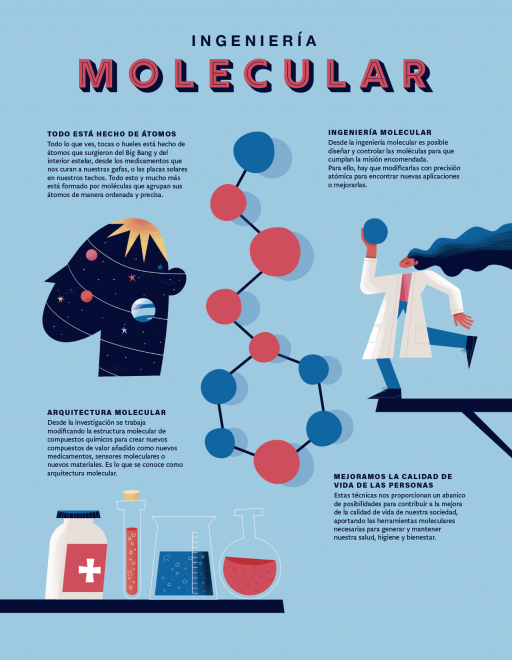Life: a molecular architecture
Every organism is made of atoms linked by chemical bonds, which can be broken and transformed.
Everything you see, touch and smell is made of atoms. These infinitesimal particles of life are grouped together into molecules, which are unwittingly capable of generating and assembling life as we know it. But do not be fooled by the unperturbed state of this mass of atoms: they can be stripped of their power. Behind every life process is a molecule that supports it. Molecular engineering is capable of shaping, breaking down and controlling the structure of this array, to develop powerful medicines, make ever stronger materials, or completely change the properties of fabrics used in the clothes we wear. The possibilities are endless, allowing this architectural work to contribute to preserving the health of the population, to reducing inequality in the world or producing materials that will help make our cities more sustainable.
It is chemistry that forms these molecules through electronic bonds. Atoms play around and turn into different compounds depending on the situation of the surrounding environment. Hydrogen and oxygen atoms can be transformed into water molecules, but if they encounter carbon on their way, they can also be converted into substances like acetone. Following in the wake of nature and "knowing how atoms recognize each other", as expressed by Fernando Tellado, a member of the molecular engineering group at the Institute of Natural Products and Agrobiology (IPNA-CSIC), "chemists seek to replicate in the laboratory the molecular construction programs that nature has been perfecting over the millennia". All this, through efficient, economical and environmentally friendly methods.
Using heat or radiation, these scientific cooks are able to break the electronic bonds that have held these atoms together, to transform them into new molecules, which in turn form new products that are totally different from their sources. This is the work of molecular engineers and requires knowledge of molecular structure at its most intimate level, as well as the use of two tools: thermodynamics and kinetics.
The former tells us whether the process is possible, the latter whether it is viable. To use a musical simile, the process of molecular construction can be said to be a dance in which the chemists provide the music and choreography and the atoms dance only with their assigned partner. While the music has to be performable according to a defined score (the rules of chemistry), the choreography must be followed step by step by the dancing body (the chemical reaction or process).
Chemists are experts in controlling these processes to create compounds with added value, hence chemistry is called the central science: it produces the materials that other sciences need for their studies and applications. Using only the most common atoms (mainly carbon, hydrogen, oxygen and nitrogen), the number of possible molecules stretches beyond our comprehension: 1060 (that is, a 1 followed by 60 zeros!). A figure that even exceeds the number of stars in the universe, estimated at 1025. The range of possibilities is enormous and their role will become very important in the coming decades, because due to their existence it will be viable to reutilize compounds that have hitherto been totally discarded, which could make a difference to the future of humanity.




